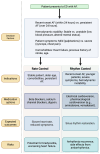Bridging the Gaps in Atrial Fibrillation Management in the Emergency Department
- PMID: 39852298
- PMCID: PMC11766356
- DOI: 10.3390/jcdd12010020
Bridging the Gaps in Atrial Fibrillation Management in the Emergency Department
Abstract
Atrial fibrillation (AF) frequently presents in emergency departments (EDs), contributing significantly to adverse cardiovascular outcomes. Despite established guidelines, ED management of AF often varies, revealing important gaps in care. This review addresses specific challenges in AF management for patients in the ED, including the nuances of rate versus rhythm control, the timing of anticoagulation initiation, and patient disposition. The updated 2024 European Society of Cardiology (ESC) guidelines advocate early rhythm control for select patients while recommending rate control for others; however, uncertainties persist, particularly regarding these strategies' long-term impact on outcomes. Stroke prevention through timely anticoagulation remains crucial, though the ideal timing, especially for new-onset AF, needs further research. Additionally, ED discharge protocols and follow-up care for AF patients are often inconsistent, leaving many without proper long-term management. Integration of emerging therapies, including direct oral anticoagulants and advanced antiarrhythmic drugs, shows potential but remains uneven across EDs. Innovative multidisciplinary models, such as "AF Heart Teams" and observation units, could enhance care but face practical challenges in implementation. This review underscores the need for targeted research to refine AF management, optimize discharge protocols, and incorporate novel therapies effectively. Standardizing ED care for AF could significantly reduce stroke risk, lower readmission rates, and improve overall patient outcomes.
Keywords: arrhythmia; atrial fibrillation; emergency medicine.
Conflict of interest statement
The authors declare no conflicts of interest.
Figures



References
-
- Roth G.A., Mensah G.A., Johnson C.O., Addolorato G., Ammirati E., Baddour L.M., Barengo N.C., Beaton A., Benjamin E.J., Benziger C.P., et al. Global Burden of Cardiovascular Diseases and Risk Factors, 1990–2019: Update from the GBD 2019 Study. J. Am. Coll. Cardiol. 2020;76:2982–3021. doi: 10.1016/j.jacc.2020.11.010. - DOI - PMC - PubMed
Publication types
LinkOut - more resources
Full Text Sources

